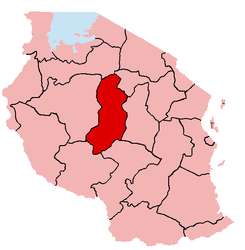- Singida (Region)
-
Singida 
Basisdaten Staat Tansania Hauptstadt Singida Fläche 49.341 km² Einwohner 1.091.000 (Volkszählung 2002) Dichte 22,1 Einwohner pro km² ISO 3166-2 TZ-23 Singida ist eine Region im Zentrum Tansanias mit etwas über 1 Mio. Einwohnern[1], deren Hauptstadt ebenfalls Singida heißt. Sie ist in die vier Distrikte Iramba, Manyoni, Singida Rural und Singida Urban eingeteilt.
Inhaltsverzeichnis
Geographie
Die Region nimmt den nördlichen Teil des zentralen Plateaus von Tansania ein. Nach Westen fällt sie zum Rift Valley und nach Osten zur Wembere-Depression hin ab. Sie ist zum Großteil arid, wobei die Regenmengen generell nach Süden hin abnehmen. 23 % des Landes in Singida sind ackerbaulich nutzbar (wovon ein Viertel oder 6,6 % der Gesamtfläche tatsächlich entsprechend genutzt werden), 40 % sind (potenzielles) Weideland, 36 % sind Waldland, insbesondere Miombo.
Bevölkerung
Größte Volksgruppen in Singida sind die Nyiramba, Nyaturu, Kimbu, Gogo, Isanzu, Taturu, Sukuma, Mang'ati, Barabaig und Hadzabe. Ferner leben hier wenige Nyamwezi und Luo aus anderen Regionen und vorwiegend in Städten einige Asiaten und Araber.
Wirtschaft
95 % der Bevölkerung sind in der Landwirtschaft tätig. Der Ackerbau produziert vor allem Mais, Hirse, Fingerhirse, Sorghum, Paddy, Kassava und Süßkartoffeln und als Cash Crops Sonnenblumen, Baumwolle, Tabak, Weizen. Bohnen, Erdnüsse, Erbsen und Zwiebeln produziert. In der Viehzucht werden 1,4 Mio. Rinder, 0,7 Mio. Ziegen, 0,4 Mio. Schafe, 42.000 Esel und 1,1 Mio. Stück Geflügel gehalten. Von den rund 1,58 Mio. Hektar Land in Singida, die sich theoretisch als Weideland eignen würden, sind allerdings 80 % mit Tsetsefliegen verseucht, auf den übrigen 20 % besteht das Problem der Überweidung.
Industrie und Bergbau sind von geringer Bedeutung. Es bestehen Pläne, die Gewinnung von Honig und Bienenwachs aus den Wäldern zu fördern. Um die entsprechenden natürlichen Ressourcen zu schützen und den Tourismus anzukurbeln, sind 31 % der Fläche der Region unter Schutz gestellt worden. Auch das landwirtschaftliche Potenzial soll vermehrt genutzt werden.
Quellen
- The United Republic of Tanzania: Singida Region Socio-Economic Profile (1997) (englisch; PDF-Datei; 18 kB)
- ↑ bevölkerungsstatistik.de, Volkszählung 2002
Verwaltungsgliederung TansaniasArusha | Daressalam | Dodoma | Iringa | Kagera | Kigoma | Kilimandscharo | Lindi | Manyara | Mara | Mbeya | Morogoro | Mtwara | Mwanza | Pemba North | Pemba South | Pwani | Rukwa | Ruvuma | Shinyanga | Singida | Tabora | Tanga | Zanzibar Central/South | Zanzibar North | Zanzibar Urban/West
Wikimedia Foundation.
Schlagen Sie auch in anderen Wörterbüchern nach:
Singida (region) — Singida (région) Région de Singida Administration Pays Tanzanie Type Région Capitale … Wikipédia en Français
Singida (région) — 05°30′S 34°30′E / 5.5, 34.5 … Wikipédia en Français
Singida — is one of the regions of Tanzania. The region is bordered to the North by Shinyanga Region, to the Northeast by Manyara Region, to the East by Dodoma Region, to the Southeast by Iringa Region, to the Southwest by Mbeya Region and to the West by… … Wikipedia
Singida (Tansania) — Singida … Deutsch Wikipedia
Singida — (région) Région de Singida Administration Pays Tanzanie Type Région Capitale … Wikipédia en Français
Singida Urban — is one of the 4 districts of the Singida Region of Tanzania. It is bordered to the North by the Iramba District, to the Northeast by the Manyara Region, to the South by the Manyoni District and to the West by the Singida Rural District. The… … Wikipedia
Singida — steht für: Singida (Region), eine Region in Tansania Singida (Tansania), eine Stadt in der gleichnamigen Region in Tansania Singida Rural und Singida Urban Singida (Fisch), ein fossiler Fisch Diese Seite ist eine … Deutsch Wikipedia
Singida Rural — is one of the 4 districts of the Singida Region of Tanzania. It is bordered to the North by the Iramba District, to the East by the Singida Urban District, to the South by the Manyoni District and to the West by the Tabora Region.According to the … Wikipedia
Région de Kigoma — Localisation de la région de Kigoma en Tanzanie Administration Pays Tanzanie Type … Wikipédia en Français
Singida — ► Región del centro de Tanzania, en Tanganica; 49 340 km2 y 791 814 h. Cap., la c. homónima (29 252 h) … Enciclopedia Universal
